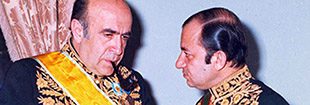Critical Perspectives
Art historians such as Umberto Baldini, president of the International University of Art in Florence, hailed Farshchian as a “turning point” in Iranian painting. Baldini emphasized that understanding the esoteric dimensions of Farshchian’s work required patience and a deep vision—qualities mirrored in the artist’s own painstaking process.
Critics often highlight his dual achievement: preserving the delicate beauty of Persian miniature while liberating it from static formalism. His works are thus not merely nostalgic but vibrantly alive, engaging with both historical memory and contemporary sensibilities.
Conclusion
Mahmoud Farshchian’s life was a journey of artistic devotion, cultural preservation, and creative innovation. From the bazaars of Isfahan to the museums of Europe, from teaching in Tehran to exhibiting in New York, his path reflected both a rootedness in tradition and a fearless embrace of change. His paintings remain not only as works of art but as visual poems—expressions of beauty, spirituality, and humanity.
Through his brush, Farshchian bridged centuries of Persian culture with the global art world, ensuring that the Persian miniature tradition would not fade into the past but instead find renewed life in the modern era. His death in 1404 marked the end of an era, but his legacy continues to inspire artists and audiences worldwide.

